Sigma 18-250mm f/3.5-6.3 DC Macro OS HSM Verdict
Superzoom lenses are often full of compromises, but in this 18-250mm lens from Sigma, the compromises are few and far between. It may be the case that shorter zoom ranges may yield better performance overall, but if you’re after a convenient all-in-one lens for travel, then the sharpness delivered by this lens certainly makes it worthy of serious consideration, especially when compared to manufacturer’s own superzoom offerings. It’s lighter, more compact, cheaper, offers more reach and performs about as well, if not better in some areas.
| The Sigma 18-250mm f/3.5-6.3 DC Macro lens is a convenient all-in-one lens delivers sharp results making it worthy of serious consideration |
Sigma 18-250mm f/3.5-6.3 DC Macro OS HSM Cons
f/6.3 max aperture at 250mm is relatively slowNo full time manual focus override (which isn’t really much of an issue)
| FEATURES | ||
| HANDLING | ||
| PERFORMANCE | ||
| VALUE FOR MONEY | ||
| OVERALL |
Sigma 18-250mm F3.5-6.3 DC OS MACRO HSM Specifications
| Lens Construction | 16 Elements in 13 Groups |
| Angle of View (diagonal) | 76.5 6.5 degrees |
| Coverage | APS-C frame |
| Number of Diaphragm Blades | 7 |
| Maximum Aperture | f3.5 (18mm) f6.3 (250mm) |
| Minimum Aperture | f22 |
| Working Distance | 35cm / 13.8in |
| Filter Size (mm) | 62mm |
| Maximum Magnifications | 1:2.9 |
| Dimensions (Diameter x Length) |
73.5mmx88.6 mm/2.9inx3.5 in |
| Weight | 470g / 16.6oz. |
| Mounts | Canon, Nikon, Pentax, Sigma, Sony (not OS) |
Here’s the optical configuration. The SLD element is shown in blue and the aspheric elements are shown in red
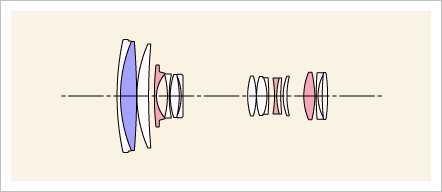
Sigma’s MTF plots are shown below
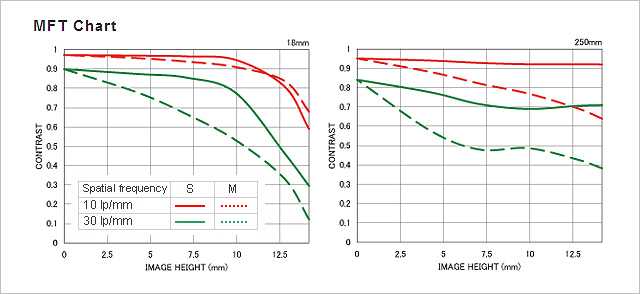
The MTF plots are for the lens wide open (f3.5 at 18mm, f6.3 at 250mm). The «M» lines are meridional and the «T» lines are Tangential. When the «M» and «T» lines differ, that’s an indication of the degree of astigmatism at that point in the frame.
Sigma 18-250mm f/3.5-6.3 DC Macro OS HSM Handling and features
For a lens that covers an impressive 13.8x zoom range, the Sigma 18-250mm DC Macro OS HSM collapses down very small indeed, and weighs only 470g. You’d be forgiven for getting it mixed up with one of the standard 18-135mm kit lenses manufacturers offer. The thermally stable composite material used for much of the lens barrel doesn’t look overly special, but it feels tough, despite its light weight. A metal lens mount provides reassurance that this lens is built well. The light weight and small size make this an ideal ‘walkabout’ companion for entry level bodies and it even feels at home on the Canon EOS 7D used for testing.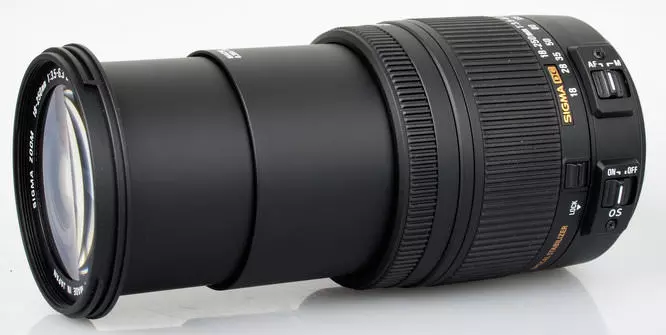
Sigma 18-250mm Lens extended
Sigma’s HSM focusing motor provides fast, silent and accurate autofocus throughout the zoom range. The lens rarely hunts for a lock, even in dim lighting conditions. This lens doesn’t support full time manual focus override, unlike higher specified Sigma lenses do. Focusing is performed internally, so the 62mm filter ring does not rotate, which makes this lens ideal for use with graduated and polarising filters.
The optical stabilisation system fitted to this lens promises sharp hand held photos at shutter speeds up to four stops slower than would normally be possible. The OS system provides a very steady viewfinder image and with care, sharp shots are possible at 1/25sec and 250mm, around three quarters of the time, which is four stops slower than the usual rule of thumb would allow.
Sigma 18-250mm f/3.5-6.3 DC Macro OS HSM Performance
As is the case with most superzoom lenses, sharpness at 18mm is excellent in the centre and good towards the edges of the frame at maximum aperture. Although stopping down improves the clarity towards the edges of the frame slightly, it does at the expense of the sharpness in the centre. Peak sharpness is achieved between f/4 and f/8 at this focal length.
With most superzoom lenses, you may expect to see a drop off in performance as the lens is zoomed in. This Sigma 18-250mm optic still holds up well at 80mm, with very good sharpness across the frame at maximum aperture and outstanding clarity across the frame at f/8.
Finally at 250mm, sharpness does drop off a little, but at maximum aperture, sharpness is still good in the centre of the frame and fairly good towards the edges. Peak quality for this focal length is achieved at f/11, where sharpness is excellent in the centre, and good towards the edges.
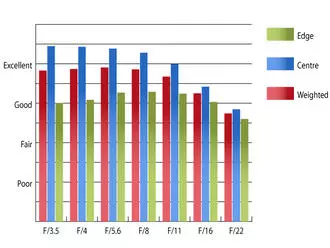 Resolution at 18mm |
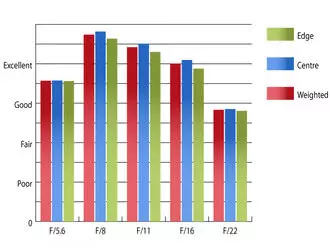 Resolution at 80mm |
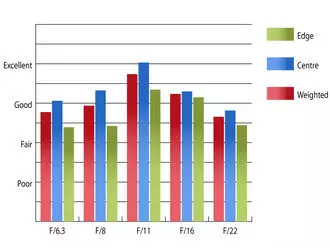 Resolution at 250mm |
The blue column represents readings from the centre of the picture frame at the various apertures and the green is from the edges. Averaging them out gives the red weighted column.The scale on the left side is an indication of actual image resolution. The taller the column, the better the lens performance. Simple.For this review, the lens was tested on a Canon EOS 7D using Imatest. |
Again, for a superzoom, Chromatic aberrations are very well controlled throughout the zoom range. Fringing can be at its strongest at 250mm near the edges of the frame, but even then levels are still below one pixel width.
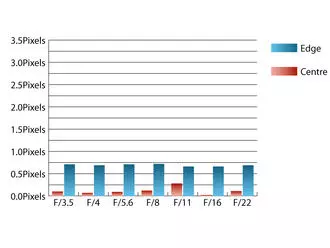 Chromatic aberration @ 18mm |
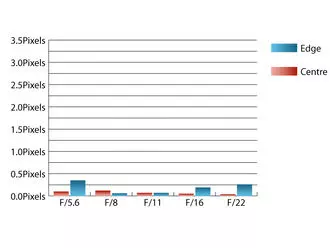 Chromatic aberration @ 80mm |
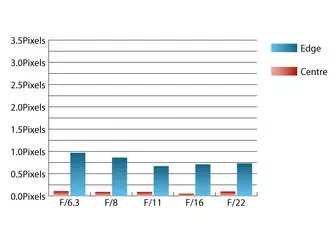 Chromatic aberration @ 250mm |
Chromatic aberration is the lens’ inability to focus on the sensor or film all colours of visible light at the same point. Severe chromatic aberration gives a noticeable fringing or a halo effect around sharp edges within the picture. It can be cured in software. |
Falloff of illumination towards the corners of the frame is well controlled throughout the zoom range. At 18mm the corners are only 1.38 stops darker than the image centre and visually uniform illumination is achieved by f/5.6. At 250mm the corners are only 0.99 stops darker than the centre and all discernible traces of vignetting are gone by f/11.
Distortion is also well controlled for a superzoom lens, with a fairly noticeable level of 3.04% barrel distortion at 18mm and 1.28% pincushion at 250mm. The distortion pattern remains uniform across the frame throughout the zoom range, so it should be relatively straightforward to correct in image editing software afterwards.
No issues out of the ordinary were had regarding flare and loss of contrast when shooting into the light. When shooting wide open at 250mm into the light, contrast does drop off noticeably, but this can be improved by stopping down.
Sigma 18-250mm F3.5-6.3 DC OS MACRO HSM — Distortion
Image distortion is visible across the focal length range, especially with subjects that have straight lines parallel to the frame edges (e.g. shots of building or posters). At 18mm there’s around 3% barrel distortion which rapidly drops as th elens is zoomed to 22m at which point distortion is at a minimum. From there on up distortion rapidly rised to about 3% again at 35mm, but this time it’s pincushion distortion. There’s not a lot of change from there, with an averge of around 2% pincushion distortion from 80mm though 250mm.
Simple distortion can be digitally corrected quite easily, so most of the distortion is correctable. However at some focal lengths there is an element of complex distortion which is a little more difficult to fully correct for.
Sigma 18-250mm F3.5-6.3 DC OS MACRO HSM — Macro
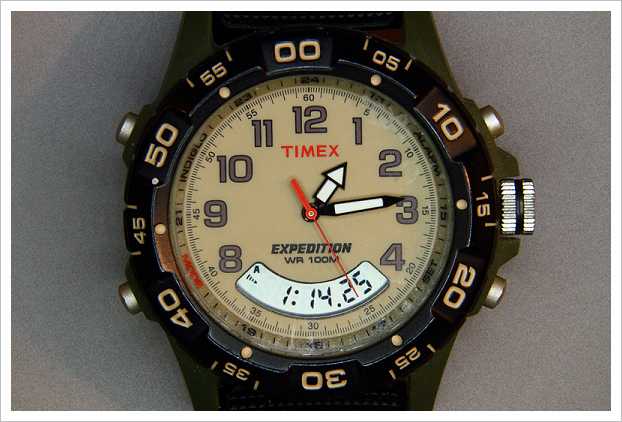 Macro at 250mm and f22
Macro at 250mm and f22The Sigma 18-250mm F3.5-6.3 DC OS MACRO HSM is a macro lens in the sense that it can focus quite closely and magnify more than most non-macro lenses (to about 1/3 life size). However it’s not a macro lens in the sense of a lens designed to have a very flat field and yield the highest resolution high magnification images. It might better be called by the term «close focus» which more accurately describes its capabilities. I guess «close focus» lenses now tend to be called «macro» by most manufacturers.
At closest focus with the lens set to 250mm there’s about 9cm (3.5″) between the subject and the front element of the lens and the magnification is about 0.34, i.e. 1/3 life size. The sharpness wide open is fair but not great and gets better when the lens is stopped down, but even at f11 or f16 it’s not as sharp as a true macro lens would be. Having to stop down for best sharpness isn’t that much of an issue because the shallow depth of field at 0.34x means that for most 3-dimensional objects you would need to stop down anyway.
Reasons to Buy Sigma 18-250mm F3.5-6.3 DC OS HSM Lens
Here we’ve included a summary of the advantages and disadvantages of the Sigma 18-250mm F3.5-6.3 DC OS HSM lens in a list form to help you determine whether it offers the features you need.
PROs
| Optical Image Stabilization |
| Autofocus |
| Distance Scale |
| DoF(Depth of Field) Scale |
| Hood supplied |
| Zoom Lock |
| Versatile Lens with a Zoom Ratio of 13x |
Report a correction
Buy Sigma 18-250mm F3.5-6.3 DC OS HSM from or B&H PHOTO
CONs
| Lens Extents while zooming |
| Slow Aperture at Tele end |
| Variable Aperture |
Lens Mount
Sigma 18-250mm F3.5-6.3 DC OS HSM is compatible with cameras that have a Nikon F (DX) lens mount. Some of the latest released cameras that are compatible with the Nikon F (DX) lenses are Nikon D3500, Nikon D7500 and Nikon D5600.
Sigma 18-250mm F3.5-6.3 DC OS HSM is also available in Canon EF , Nikon F (DX), Pentax KAF3, Sony Alpha, Sigma SA, Canon EF, Pentax KAF3, Sony Alpha and Sigma SA mounts.
Size, Weight and Filter Thread
Size and weight is a very important decision factor when searching for your next lens. Sigma 18-250mm F3.5-6.3 DC OS HSM has a maximum diameter of 79mm and total length of 101mm when not extended. It weighs 628g / 22.2 oz.
Sigma 18-250mm F3.5-6.3 DC OS HSM has a filter thread of 72mm. Below are links to the filters that we recommend you to consider for your Sigma 18-250mm F3.5-6.3 DC OS HSM:
Optical Image Stabilization
The Sigma 18-250mm F3.5-6.3 DC OS HSM features an optical image stabilization system which helps to reduce the blur that occurs due to shaking during hand-held shooting.
Zoom Method
Sigma 18-250mm F3.5-6.3 DC OS HSM features Rotary (extending) zoom method where the length of the lens changes as you zoom in or out. This makes it possible to design the lens with a smaller minimum length ( generally when it is zoomed out) compared to internal zoom lenses. The disadvantages of this design are being harder to seal against dust and moisture, weight balance shifting while zooming and zoom creep in certain lenses.
Zoom Lock
Sigma 18-250mm F3.5-6.3 DC OS HSM has a Zoom lock feature which eliminates Zoom creep where focal length of the lens changes with gravity when it’s held downwards or upwards.
Maximum Magnification Ratio
Sigma 18-250mm F3.5-6.3 DC OS HSM has a Max Magnification Ratio of 0.29x and has a minimum focusing distance of 0.45m. For a non-macro lens, the 0.29x is considered a high magnification and will come handy for close-up shots.
Below are the 3 Super Telephoto Zoom type Nikon F mount lens alternatives with highest max magnification ratios:
- Tamron 18-400mm F3.5-6.3 VC: 0.34x — (Compare)
- Tamron 16-300mm f3.5-6.3 II VC PZD: 0.34x — (Compare)
- Sigma 18-300 F3.5-6.3 DC OS HSM: 0.33x — (Compare)
Aperture
Sigma 18-250mm F3.5-6.3 DC OS HSM is a variable aperture lens with a max aperture of f3.5 and a minimum aperture of f22 at 18mm, and a max aperture of f6.3 and minimum aperture of f40 at 250mm .
| Focal Length | Max Aperture | Min Aperture |
|---|---|---|
| 18mm | F3.5 | F22 |
| 250mm | F6.3 | F40 |
Optical Formula
Sigma 18-250mm F3.5-6.3 DC OS HSM’s optical formula consists of 18 elements in 14 groups . Special elements used in this design is 4 SLD glass elements 3 aspherical elements.
Lens Hood
Sigma 18-250mm F3.5-6.3 DC OS HSM comes with a removable lens hood which is handy to reduce lens flare and glare in your photos.
Popular Comparisons of Sigma 18-250mm F3.5-6.3 DC OS HSM
Top Alternatives of Sigma 18-250mm F3.5-6.3 DC OS HSM Lens
| Model | Coverage | Weight | Focusing | Street Price | |
|---|---|---|---|---|---|
|
Nikon AF-S DX Nikkor 18-140mm f3.5-5.6G ED VR Compare |
APS-C / DX | 490 g / 1.08 lb | AF | ||
|
Nikon AF-S DX Nikkor 18-105mm f3.5-5.6G ED VR Compare |
APS-C / DX | 420 g / 0.92 lb | AF | ||
|
Nikon AF-S DX Nikkor 18-200mm f3.5-5.6G ED VR II Compare |
APS-C / DX | 565 g / 1.24 lb | AF | ||
|
Tamron 18-270mm F3.5-6.3 Di II VC PZD Compare |
APS-C / DX | 450 g / 0.99 lb | AF | ||
|
Tamron 18-400mm F3.5-6.3 Di II VC HLD Compare |
APS-C / DX | 710 g / 1.56 lb | AF | ||
|
Sigma 18-250mm F3.5-6.3 DC Macro OS HSM Compare |
APS-C / DX | 470 g / 1.03 lb | AF | ||
|
Nikon AF-S DX NIKKOR 18-300mm F3.5-6.3G ED VR Compare |
APS-C / DX | 550 g / 1.21 lb | AF | ||
|
Sigma 18-300 F3.5-6.3 DC Macro OS HSM Compare |
APS-C / DX | 585 g / 1.29 lb | AF |
Sigma 18-250mm F3.5-6.3 DC OS MACRO HSM — Sharpness
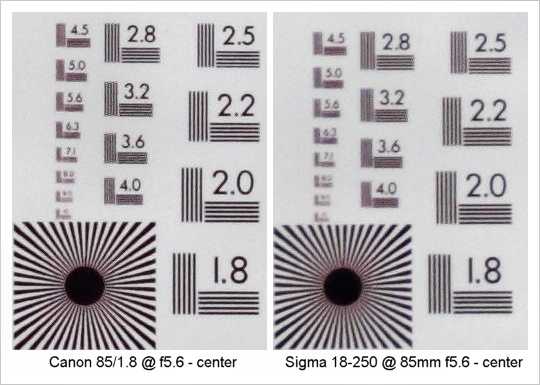 Left: Canon EF 85/1.8 @ f5.6 image center Right: Sigma 18-250 @ 85mm f5.6 image center
Left: Canon EF 85/1.8 @ f5.6 image center Right: Sigma 18-250 @ 85mm f5.6 image centerIn general at all focal lengths center sharpness was quite good. Good enough that for general purpose shooting there is no need to stop down. Sharpness does improve slightly in the center on stopping down slightly, especially at longer focal length settings, but this is a lens you could shoot wide open if center sharpness is your main concern.
The 100% crops above compare the center of images shot using and EOS 7D with a Canon EF 85/1.8 stopped down to f5.6 and the Sigma 18-250mm F3.5-6.3 DC OS MACRO HSM also at 85mm and f5.6 (which is wide open for that lens). While the image taken with the Canon lens is a little sharper and higher in contrast, the image shot with the Sigma is surprisingly close. Stopping down brings up the contrast a little, but if you needed the speed, shooting at f5.6 is certainly quite practical.
Corner sharpness is a different matter though. At 18mm wide open the corners are soft, but they get better as the lens is stopped down. They probably peak in the f11 to 16 range. At 85mm corner sharpness was better, probably due in part to the fact that 85mm is the setting at which chromatic aberration is best controlled. At 250mm corners were a little softer again and stopping down produced an improvement.
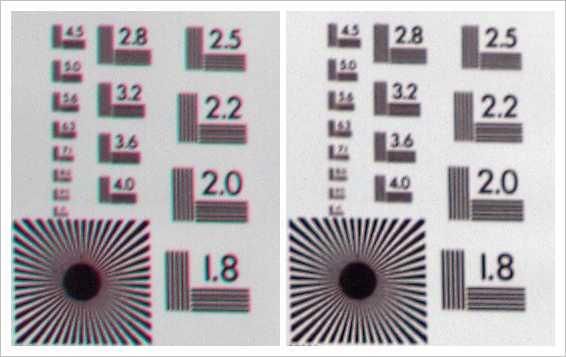 Left: Corner of image at 18mm and f3.5 Right: Same image after digital correction for chromatic aberration
Left: Corner of image at 18mm and f3.5 Right: Same image after digital correction for chromatic aberrationSince the effect of chromatic aberration is one of the factor that is responsible for softening the corners, CA correction not only clears up color fringing at the edges and corners of the image, but also results in increased sharpness.
The bottom line here is that if your main subject is in the center of the frame and you don’t care about the corners (or the corners are out of focus anyway due to depth of field considerations, you can safely shoot wide open. If you want to be sure of peaking center sharpness you can stop down a stop, but if you want the corners to be as good as they get, you’ll need to stop down to f11 or more.
Reasons to Buy Sigma 18-250mm F3.5-6.3 DC Macro OS HSM Lens
Here we’ve included a summary of the advantages and disadvantages of the Sigma 18-250mm F3.5-6.3 DC Macro OS HSM lens in a list form to help you determine whether it offers the features you need.
PROs
| Optical Image Stabilization |
| Autofocus |
| Distance Scale |
| DoF(Depth of Field) Scale |
| Hood supplied |
| Full-time Manual Focusing |
| Zoom Lock |
| Versatile Lens with a Zoom Ratio of 13x |
Report a correction
Buy Sigma 18-250mm F3.5-6.3 DC OS HSM from or B&H PHOTO
CONs
| No Weather Sealing |
| Lens Extents while zooming |
| Slow Aperture at Tele end |
| Variable Aperture |
Lens Mount
Sigma 18-250mm F3.5-6.3 DC OS HSM is compatible with cameras that have a Nikon F (DX) lens mount. Some of the latest released cameras that are compatible with the Nikon F (DX) lenses are Nikon D3500, Nikon D7500 and Nikon D5600.
Sigma 18-250mm F3.5-6.3 DC OS HSM is also available in Canon EF , Pentax KAF3, Sony Alpha, Sigma SA, Canon EF, Nikon F (DX), Pentax KAF3, Sony Alpha and Sigma SA mounts.
Size, Weight and Filter Thread
Size and weight is a very important decision factor when searching for your next lens. Sigma 18-250mm F3.5-6.3 DC OS HSM has a maximum diameter of 74mm and total length of 89mm when not extended. It weighs 470g / 16.6 oz.
Sigma 18-250mm F3.5-6.3 DC OS HSM has a filter thread of 72mm. Below are links to the filters that we recommend you to consider for your Sigma 18-250mm F3.5-6.3 DC OS HSM:
Optical Image Stabilization
The Sigma 18-250mm F3.5-6.3 DC OS HSM features an optical image stabilization system which helps to reduce the blur that occurs due to shaking during hand-held shooting.
Zoom Method
Sigma 18-250mm F3.5-6.3 DC OS HSM features Rotary (extending) zoom method where the length of the lens changes as you zoom in or out. This makes it possible to design the lens with a smaller minimum length ( generally when it is zoomed out) compared to internal zoom lenses. The disadvantages of this design are being harder to seal against dust and moisture, weight balance shifting while zooming and zoom creep in certain lenses.
Zoom Lock
Sigma 18-250mm F3.5-6.3 DC OS HSM has a Zoom lock feature which eliminates Zoom creep where focal length of the lens changes with gravity when it’s held downwards or upwards.
Below are the 3 Super Telephoto Zoom type Nikon F mount lens alternatives with highest max magnification ratios:
- Tamron 18-400mm F3.5-6.3 VC: 0.34x — (Compare)
- Tamron 16-300mm f3.5-6.3 II VC PZD: 0.34x — (Compare)
- Sigma 18-300 F3.5-6.3 DC OS HSM: 0.33x — (Compare)
Aperture
Sigma 18-250mm F3.5-6.3 DC OS HSM is a variable aperture lens with a max aperture of f3.5 and a minimum aperture of f0 at 18mm, and a max aperture of f6.3 and minimum aperture of f0 at 250mm .
| Focal Length | Max Aperture | Min Aperture |
|---|---|---|
| 18mm | F3.5 | F0 |
| 250mm | F6.3 | F0 |
Lens Hood
Sigma 18-250mm F3.5-6.3 DC OS HSM comes with a removable lens hood which is handy to reduce lens flare and glare in your photos.
Popular Comparisons of Sigma 18-250mm F3.5-6.3 DC OS HSM
Top Alternatives of Sigma 18-250mm F3.5-6.3 DC OS HSM Lens
| Model | Coverage | Weight | Focusing | Street Price | |
|---|---|---|---|---|---|
|
Tamron 18-270mm F3.5-6.3 Di II VC PZD Compare |
APS-C / DX | 450 g / 0.99 lb | AF | ||
|
Nikon AF-S DX Nikkor 18-200mm f3.5-5.6G ED VR II Compare |
APS-C / DX | 565 g / 1.24 lb | AF | ||
|
Tamron 16-300mm F3.5-6.3 Di II VC PZD Macro Compare |
APS-C / DX | 540 g / 1.19 lb | AF | ||
|
Sigma 18-300 F3.5-6.3 DC Macro OS HSM Compare |
APS-C / DX | 585 g / 1.29 lb | AF | ||
|
Nikon AF-S DX Nikkor 18-300mm F3.5-5.6G ED VR Compare |
APS-C / DX | 830 g / 1.83 lb | AF | ||
|
Nikon AF-S DX NIKKOR 18-300mm F3.5-6.3G ED VR Compare |
APS-C / DX | 550 g / 1.21 lb | AF | ||
|
Nikon AF-S DX Nikkor 18-140mm f3.5-5.6G ED VR Compare |
APS-C / DX | 490 g / 1.08 lb | AF | ||
|
Sigma 18-250mm F3.5-6.3 DC OS HSM Compare |
APS-C / DX | 628 g / 1.38 lb | AF |
Sigma 18-250mm F3.5-6.3 DC OS MACRO HSM — Focus Breathing
Just a note that like most inexpensive close focusing wide range zoom lenses (and some not so inexpensive narrower range zoom lenses), the effective focal length of the lens decreases as focus distance decreases. This is often called «focus breathing». So while focused at infinity the focal length of the Sigma 18-250mm F3.5-6.3 DC OS MACRO HSM at the 250mm setting is around 250mm (I measured 240mm), at closer focus distance it decreases. I measured around 190mm at a focus distance of 4m and 150mm at a focus distance of 2m. What this means is that you have to take a step closer to your subject than you might otherwise have to if the focal length remained constant. As I said, a lot of lenses do this so it’s more something to be aware of than to worry about.
Sigma 18-250mm F3.5-6.3 DC OS MACRO HSM — Alternatives
The alternatives to the Sigma 18-250mm F3.5-6.3 DC OS MACRO HSM all suffer from the same compromises between size, weight, zoom range, sharpness and cost. The TAMRON 18-270mm F/3.5-6.3
Di II VC PZD is probably the major competitor for the Sigma lens. It is a little longer (270mm vs 250mm) at the telephoto end of the range and it holds onto an f5.6 aperture a little longer (to 168mm vs 128mm for the Sigma). On the other hand the macro is only 1:3.8 (0.26x) whereas the Sigma is capable of 1:2.9 (0.34x). Both lenses have effective image stabilization, both come with a lens hood. The Tamron has a 6 year warranty while the Sigma warranty is 3 years (after registration). The two lenses are almost identical in size and weight (the Tamron is 20g lighter) and the current prices (03/13) are $449 for the Tamron lens and $399 for the Sigma, so there’s not a whole lot of difference there either. Both lenses are sharp in the center of the field. not so sharp in the corners and better at mid focal lengths than at the extremes of the zoom range. so there’s really not a huge amount of difference between them.
A radically different alternative might be to go a totally different route to a fairly small lightweight «do everything» camera system and consider, for example, the Panasonic Lumix DMC-FZ200.
Yes, it’s a small sensor digicam without interchangeable lenses, but the lens it does have is pretty impressive. It has a optically stabilized LEICA DC VARIO-ELMARIT 25-600mm f2.8 zoom (in 35mm full frame equivalent terms). That’s f2.8 across the whole zoom range, even at an effective focal length of 600mm. The lens has 14 elements in 11 groups, 5 Aspherical Lenses with 9 Aspherical surfaces, 3 ED Lenses and 1 Nano Surface Coating Lens. Impressive specs. The 12.1MP sensor doesn’t push the pixel count too hard and the ISO range of 100-3200 (6400 with boost) combined with an f2.8 lens gives good low light capability. Something to think about…
Sigma 18-250mm F3.5-6.3 DC OS MACRO HSM — Conclusions
Though the Sigma 18-250mm F3.5-6.3 DC OS MACRO HSM may not be the sharpest and fastest of lenses it nevertheless represents a very useful lens for travel and other applications where size and weight are of primary importance. It covers a wide range of focal lengths from 18mm to 250mm (which translates to the same field of view as would be given by a 28-400mm lens on a full frame camera). It also provides close focus capability with 1/3 life size imaging along with an effective image stabilization system.
Like all such lenses there is a compromise to be made. There is visible distortion, though that can be digitally corrected fairly easily. It’s rather slow at the telephoto end of the range (f6.3 from around 128mm to 250mm), though that can be compensated for to some extent by using higher ISO settings, and higher ISO settings are now pretty good on most DSLRs. While the corners of the image tend to be a little soft, the center is quite sharp and most of the time it’s the central region of the image that’s the most important and where the main subject is.
Sigma 18-250mm F3.5-6.3 DC OS MACRO HSM would be a good choice for someone who isn’t intending to make poster size prints and wants one lens to do everything. Focus is reasonably fast and accurate, the image stabilization is effective and for casual photographers who aren’t going to pixel peep in the corners of their images displayed at 100% on a 23″ monitor, the image quality should be just fine.
Sigma 18-250mm F3.5-6.3 DC OS MACRO HSM — Description
The Sigma 18-250mm F3.5-6.3 DC Macro OS HSM is very small and light for an 18-250 zoom. It’s only 2.9″ in diameter x 3.5″ long (at the 18mm setting) and weighs only 16.6oz. The finish on the barrel is Sigma’s standard semi-matte black plastic Marking for focal length, magnification, switches etc. are printed in white, not engraved. The lens mount is metal.
Focal lengths are marked at 18, 28, 35, 50, 80, 135 and 250mm and there’s a macro scale showing the reproduction ratio at these focal lengths at the minimum focus distance of 35cm. The minimum aperture at all focal lengths is f32. The maximum aperture vaires with focal length as follows:
- 18mm – f3.5
- 28mm – f4.0
- 35mm – f4.5
- 50mm – f5.0
- 80mm – f5.6
- 135mm – f6.3
- 250mm – f6.3
The switch from an f5.6 maximum aperture to an f6.3 maximum aperture occurs at about 128mm. The barrel extends when the lens is zoomed and reaches a length of 6.25″ at full zoom (250mm). There’s a zoom lock at the 18mm position to prevent the zoom from accidentally extending while the lens is being carried.
There’s an AF/MF switch and an OS on/off switch. This lens does not have full time manual focus, so for manual focus the focus switch must be set to «MF».
Buy Now
Used Sigma 35mm f/1.4 DG HSM ART — Nikon Fit
Heavily Used £189
Used Sigma 18-35mm f/1.8 DC HSM ART — Niko…
Heavily Used £174
Used Sigma 8mm f/3.5 EX DG Fisheye — Canon…
Like New £354
Used Sigma 56mm f/1.4 DC DN Contemporary -…
Like New £324
Used Sigma 150-600mm f/5-6.3 DG OS HSM Con…
Like New £779
Used Sigma 16-28mm f/2.8 DG DN Contemporar…
Like New £724
Used Sigma 12-24mm f/4.5-5.6 EX DG — Sony…
Like New £214
Used Sigma 24mm f/1.4 DG HSM ART — Canon E…
Like New £504
Used Sigma 20mm f/1.8 EX DG — Nikon Fit
Like New £204
Used Sigma 30mm f/1.4 DC DN Contemporary -…
Like New £234
Sell or trade used photo and video kit with MPB
|
We don’t have the latest price however the link below will take you to the most relevant items. Sigma 18-250mm f/3.5-6.3 DC Macro OS HSM |
We don’t have the latest price however the link below will take you to the most relevant items. Sigma 18-250mm f/3.5-6.3 DC Macro OS HSM |
We transform the way that people buy, sell and trade in photo and video kit. USED SIGMA |
Support this site by making a Donation, purchasing Plus Membership, or shopping with one of our affiliates:
Amazon UK,
Amazon US,
Amazon CA,
ebay UK,
MPB. It doesn’t cost you anything extra when you use these links, but it does support the site, helping keep ePHOTOzine free to use, thank you.
ADVERTISEMENT
Other articles you might find interesting…
Nikkor Z DX 24mm F/1.7 Lens Review
Fujifilm XF 8mm F/3.5 Review
Canon RF-S 55-210mm Review
SIGMA AF 14mm f/1.4 DG DN | Art Lens Review
Best Third Party Nikon F Lenses (DSLR)
Astrodesign & Samyang Join The L-Mount Alliance
Best Canon EF And EF-S Lenses
Sony FE 70-200mm f/4 G OSS II Lens Announced — Take A Look A…
Фокусировка, резкость, цветопередача, геометрические искажения и другие важные параметры
Аббревиатура и технические характеристики
Маркировка объектива Sigma DC 17-50mm f/2.8 EX OS HSM расшифровывается следующим образом:
- Sigma – японская компания, производитель фототехники
- DC – объектив разработан для зеркальных фотокамер с APS-C матрицей (аналог маркировки DX зеркалок Nikon)
- 17-50mm – диапазон фокусных расстояний объектива
- f/2.8 – светосила объектива, определяет максимально возможную открытую диафрагму. В данном случае диафрагма может принимать значение f/2.8 во всем диапазоне фокусных расстояний
- EX (Excellent) – профессиональный объектив высшего класса
- OS (Optical Stabilizer) – объектив оборудован оптическим стабилизатором (аналог VR от компании Nikon)
- HSM (Hyper Sonic Motor) – в объективе установлен ультразвуковой мотор, обеспечивающий тихую и быструю фокусировку, благодаря чему, объектив будет полноценно работать на всех камерах Nikon, включая фотоаппараты начального уровня без встроенного мотора фокусировки
Кроме того, в конструкции объектива присутствуют ASP (Aspherical) – асферические и FLD (Fluorite like Low Dispersion) – низко дисперсионные элементы, подавляющие хроматические аберрации и геометрические искажения по краям кадра. По заявлениям производителя многослойное просветление оптики успешно борется с засветками и внутренними переотражениями, обеспечивая резкие и контрастные кадры даже в условиях низкого освещения. По моим личным наблюдениям резкость и контраст объектив держит хорошо, но «зайцев» ловит. Хотя, может в этом виноват UV-фильтр, накрученный на объектив.
В контровом свете резкость и контрастность практически не падают, но «зайцев» объектив ловит. ФР 20 мм, диафрагма f/22, выдержка 1/30 с, ISO 250
Еще кадр, снятый в контровом свете. ФР 50 мм, диафрагма f/4, выдержка 1/100 с, ISO 100
Технические характеристики объектива, следующие:
- Диаметр переднего фильтра – 77 мм (как у большинства профессиональных моделей)
- Кратность зума – 2,94х
- Количество лепестков диафрагмы – 7
- Диафрагма – от f/2.8 до f/22 на всем диапазоне фокусных расстояний
- Минимальная дистанция фокусировки – 0.28 м
- Максимальный коэффициент увеличения – 1:5
- Размеры – 83.5 х 91.8 мм
- Вес – 565 грамм
Объектив комплектуется удобной блендой и отличным чехлом. Бленда сидит очень плотно, потерять ее вряд ли возможно. Если одеть бленду задом наперед, доступ к кольцу фокусировки не блокируется даже на 17 мм. Чехлы, которые компания Sigma делает для своих объективов, я считаю одними из лучших. Чехол напоминает тубус из плотной ткани, только прямоугольной формы, на торцах которого внутри присутствуют толстые уплотнители, для дополнительной защиты.
В комплект входит удобная бленда и отличный чехол
На корпусе объектива расположены переключатели «AF – М» (выбор автоматической AF или ручной фокусировки M), «OS ON/OFF» (включение/отключение стабилизатора) а также блокиратор зума Lock, фиксирующий положение объектива на 17 мм фокусного расстояния.
К сожалению, в отличии от большинства объективов Nikon, Sigma 17-50mm f/2.8 EX OS HSM не поддерживает постоянный ручной контроль фокусировки. В режиме «AF» крутить кольцо фокусировки нельзя, можно повредить мотор.
По заявлениям производителя, стабилизатор обеспечивает выигрыш в 4 ступени. В моем архиве не нашлось кадров, которые могли бы это проиллюстрировать. Но, на англоязычных ресурсах встречается информация, что это заявление не далеко от истины. Кроме того, стабилизатор просто незаменим при съемке видео с рук.
Когда Sigma 17-50mm f/2.8 не присоединен к фотоаппарату или камера выключена, если объектив потрясти или просто повернуть из стороны в сторону, можно услышать шум, как будто внутри что-то перекатывается. Это не брак, а нормальное состояние. Звук издают линзы, отвечающие за работу стабилизатора, которые в выключенном состоянии не подвешены в электромагнитном поле.
Не считая этой особенности, объектив сделан очень качественно. У моего экземпляра нет никаких люфтов, резинки не растянулись, а зум не выдвигается под тяжестью собственного веса. Это несмотря на то, что я пользуюсь им уже два года, а до этого несколько лет он был в других руках. Крепление байонета – металлическое, но, к сожалению, без резинового уплотнителя.
Передняя линза объектива при зумировании и фокусировке не вращается, что позволяет без проблем использовать любые светофильтры.
Sigma 18-250mm f/3.5-6.3 DC OS HSM User Reviews
8.7/10
average of 3 review(s)
Build Quality
8.7/10
Image Quality
8.7/10
-
8 out of 10 points
and recommendedVery useful zoom range, fast and near silent focus, reasonably sharp from 18-80 mm.
Very convenient lens. Get this one with my 500D is a nice combo. No need to change between the 17-55 IS and 70-200 L as before. I can leave the two lenses at home and travel light with only one lens.
IQ is OK. ,reasonably sharp for this kind of lens, but not extremely sharp as the 17-55 IS and no sweet color as 70-200 L.
OS works well. I can set shutter speed down to 1/60 at 250mm and get a sharp image without a tripod.
I recommend this lens to everyone who want to travel light with only one body and one lens that cover very wide range from wide angle to telephoto. But if you’re very serious about sharpness DON’T buy this lens it will surely disappoint you.reviewed March 27th, 2010
(purchased for $410) -
9 out of 10 points
and recommendedGreat zoom range, Fast + accurate focusing, Nice build
Nothing reallyAfter reading all that I could find about Superzooms in general I was really hesitent to purchase this lens. Wow am I glad I did!
The images at all focal lengths are pretty good. The focus is fast and spot on and it has good sharpness + contrast. In fact, it produces sharper images than the EF 28-135mm IS USM lens that came with the Canon 50d.
After a couple of weeks of pretty heavy usage there is no lens creep at all. and it has produced many keepers.
One trade-off you have to make for such a large zoom range is a small aperture which means less indoor performance. BUT if you have a good external flash (I use the canon 430II) it works great there too.
The only one gripe I have with this lens is the focus ring will turn as it focuses and there is no full-time manual adjusting either.
Bottom line, if you need a vacation zoom get this lens!!reviewed September 24th, 2009
(purchased for $529) -
9 out of 10 points
Very fast and accurate approach. Adjustment of the notable elements and construction quality.
Excessive lateral chromatic aberrations from the 200 mm.Across all the focus on this common ground that 18-250 is the high contrast that has since its peak in the central opening and how well that holds the optical amplification to 250 mm. Las importantes ACs laterales en esquinas de la zona entre los 200 mm. The significant lateral CAs corners of the area between 200 mm. y 250 mm. and 250 mm. será el aspecto más negativo. Este comportamiento tan explosivo en el centro más la rapidez y precisión de enfoque lo hacen muy apto para incursiones deportivas y en fotografía de naturaleza. be the most negative aspect. This behavior so explosive in the center plus the speed and precision make it very suitable approach to sports raids and nature photography. En ambientes urbanos y en arquitectura, como todos los TT´s, no habrá que fijarse mucho en las líneas si no quiere uno que sufra la vista. In urban settings and architecture, as all TT’s, there will be much to look at the lines if you want one that suffers the hearing.
reviewed September 10th, 2009
(purchased for $560)

























